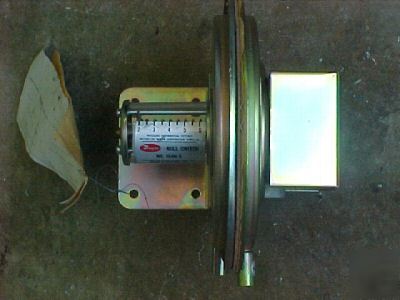Dubuque, IA Free Moderated Classifieds Site > OLD ADS FROM PREVIOUS YEARS
> 2004
> June
> Dwyer null switch pressure 1640-5
Dwyer null switch pressure 1640-5
Phone: 219/879-8000
P.O. BOX 373 • MICHIGAN CITY, INDIANA 46361, U.S.A. Fax: 219/872-9057 e-mail: ****@dwyer-inst.com
Specifications - Installation and Operating Instructions
Model 1640 Floating Contact Null Switch for High and Low Actuation
Dwyer Model 1640 Floating Contact Null Switch
to Dwyer Series 1630 Large Diaphragm Pressure Switches,
except for its electric switch. Model 1640 is equipped with a single
pole, double-throw floating contact switch (not snap action),
so it functions as a null switch.
The drawing above shows the switching action schematically. As
the diaphragm moves in response to pressure changes, it moves
the floating contact to cause switching action at two preset
points, with no switching action between these points. The “highâ€
circuit will be closed when rising pressure differential reaches the
preset level; the “low†circuit will be closed when falling pressure
differential reaches the preset level.
A typical usage for this switch is to position motorized dampers
when static pressure in a duct system reaches a desired maximum,
and to reposition the dampers when the static pressure
falls to a pre-established minimum. By using a pitot tube sensing
element, Model 1640 can serve in the same way to control air
velocity and maintain a constant volume of air in a supply duct.
Because of the very low electrical rating, the 1640
switch is almost always used with a relay which has suitable current
Rising pressure closes the “high†contact which causes the motor
to rotate in a counterclockwise direction. Decreasing pressure
closes the “low†contact and causes the motor to rotate in a
clockwise direction. When the floating contact is in the null zone
there is no switching action and motor is at rest.
©Copyright 2001 Dwyer Instruments, Inc. Printed in U.S.A. 4/01 FR# 23-440284-00 Rev. 1
Model 1640 Switches - Operating Ranges - Null Zone
-30°F (-22°C) for dry air or gas
Non-inductive — 2-1/2 amp, 110V A.C.; 1-
1/2 amp, 220V A.C.; 1 amp, 24V D.C., 1/2 amp, 110V D.C.,
Inductive - 1 amp, 110V A.C.; 1/2 amp, 220V A.C.; 1/2 amp, 24V
D.C. De-rate 70 - 80% for very slow pressure changes.
SPDT floating contact (not snap action)
3-screw type, common, high and low
For use only with air or compatible gases.
The “high†actuation point is indicated
on a calibrated scale secured to the transparent range screw
enclosure. Re-setting is accomplished by turning the adjustment
screw with a screwdriver to the desired setting on scale. The
“low†actuation point is set by adjusting the span of the null by
turning the Span Adjustment Screw on top of the switch element
inside the conduit enclosure. (See photo above.)
Special Models are available, including those with weather-
proof or explosion-proof enclosures.
Differential pressure switches shall be diaphragm operated to
actuate a single pole double throw floating contact “Null†switch.
The pressure differential at which the electrical switch will be actuated
on rising pressure shall be adjustable. Set point adjustment
shall be screw type with set point indicated on a visual scale. The
span of the floating contact switch shall be adjustable. Switches
shall be Dwyer Instruments, Inc. Catalog No. ______ for the
Adjusting the “nullâ€. Switching action in the Model 1640 null switch. Model 1640 null switch.

